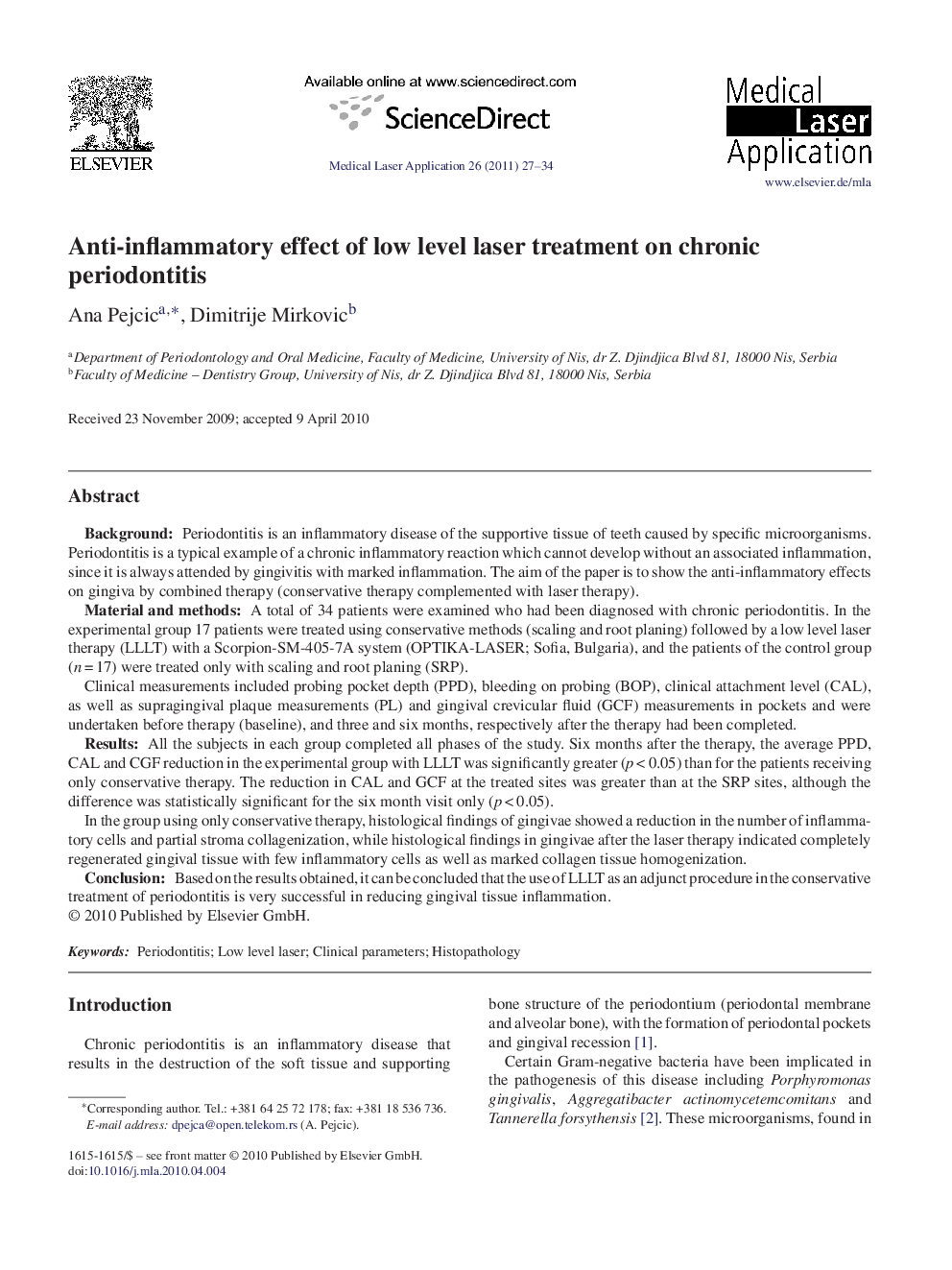| Article ID | Journal | Published Year | Pages | File Type |
|---|---|---|---|---|
| 2068155 | Medical Laser Application | 2011 | 8 Pages |
BackgroundPeriodontitis is an inflammatory disease of the supportive tissue of teeth caused by specific microorganisms. Periodontitis is a typical example of a chronic inflammatory reaction which cannot develop without an associated inflammation, since it is always attended by gingivitis with marked inflammation. The aim of the paper is to show the anti-inflammatory effects on gingiva by combined therapy (conservative therapy complemented with laser therapy).Material and methodsA total of 34 patients were examined who had been diagnosed with chronic periodontitis. In the experimental group 17 patients were treated using conservative methods (scaling and root planing) followed by a low level laser therapy (LLLT) with a Scorpion-SM-405-7A system (OPTIKA-LASER; Sofia, Bulgaria), and the patients of the control group (n = 17) were treated only with scaling and root planing (SRP).Clinical measurements included probing pocket depth (PPD), bleeding on probing (BOP), clinical attachment level (CAL), as well as supragingival plaque measurements (PL) and gingival crevicular fluid (GCF) measurements in pockets and were undertaken before therapy (baseline), and three and six months, respectively after the therapy had been completed.ResultsAll the subjects in each group completed all phases of the study. Six months after the therapy, the average PPD, CAL and CGF reduction in the experimental group with LLLT was significantly greater (p < 0.05) than for the patients receiving only conservative therapy. The reduction in CAL and GCF at the treated sites was greater than at the SRP sites, although the difference was statistically significant for the six month visit only (p < 0.05).In the group using only conservative therapy, histological findings of gingivae showed a reduction in the number of inflammatory cells and partial stroma collagenization, while histological findings in gingivae after the laser therapy indicated completely regenerated gingival tissue with few inflammatory cells as well as marked collagen tissue homogenization.ConclusionBased on the results obtained, it can be concluded that the use of LLLT as an adjunct procedure in the conservative treatment of periodontitis is very successful in reducing gingival tissue inflammation.
ZusammenfassungHintergrundParodontitis ist eine entzündliche Erkrankung des Zahnhalteapparates hervorgerufen durch Bakterien. Eine Parodontitis (Zahnbettentzündung) geht immer mit einer Gingivitis (Zahnfleischentzündung) einher. Ziel der vorgelegten Studie war es daher, die antientzündlichen Effekte einer kombinierten Therapie (konventionelle Therapie mit anschließender Softlasertherapie) auf die Gingiva zu untersuchen.Material und MethodenInsgesamt wurden 34 Patienten mit diagnostisch gesicherter chronischer Parodontitis in die Studie eingeschlossen. Die Hälfte der Patienten (n = 17) wurde zunächst konservativ mittels Kürettage behandelt, gefolgt von einer Low-Level-Lasertherapie (Scorpion-SM-405-7A; OPTIKA-LASER, Sofia, Bulgarien). Die andere Hälfte der Patienten wurde nur konservativ behandelt (Kontrollgruppe).Die klinische Evaluation erfolgte jeweils vor sowie 3 und 6 Monate nach Behandlung durch Messung der Sondierungstiefen (probing pocket depth, (PPD)) und des Attachmentlevels (clinical attachment level, (CAL)) sowie durch Beurteilung der Sondierungsblutung (bleeding on probing, (BOP)). Es wurde außerdem eine Plaquekontrolle durchgeführt sowie der Sulkusfluid (gingival crevicular fluid, (GCF)) in den Zahnfleischtaschen gemessen.ErgebnisseAlle Patienten durchliefen die Studie vollständig. 6 Monate nach Therapie waren in der Gruppe, die sich einer kombinierten Therapie mit Low-Level-Laserbehandlung unterzogen hatte, die mittleren Sondierungstiefen, Attachmentlevel und Sulkusfluidmengen gegenüber der Kontrollgruppe mit ausschließlich konservativer Behandlung signifikant reduziert (p < 0.05).Vergleicht man die absoluten Werte für CAL und GCF miteinander, so war die Reduktion in der kombinierten Behandlungsgruppe (ΔCAL = 0.97 mm, ΔGCF = 0.0022 ml) größer als in der Kontrollgruppe (ΔCAL = 0.64 mm, ΔGCF = 0.002 ml), auch wenn diese Differenzen nur für die 6-Monats-Kontrolluntersuchung statistisch signifikant waren (p < 0.05).Die histologischen Untersuchungen der Gingiva ergaben in der Kontrollgruppe einen Rückgang der Entzündungszellen und eine partielle Stromakollagenisierung. In der kombinierten Behandlungsgruppe zeigte sich eine komplette Regeneration der Gingiva mit nur noch wenigen Entzündungszellen und homogenem Bindegewebe.ZusammenfassungDie Ergebnisse der vorgelegten Studie zeigen, dass in der konservativen Parodontitisbehandlung eine ergänzende Behandlung mit dem Softlaser entzündungshemmende Wirkung auf die Gingiva hat.
